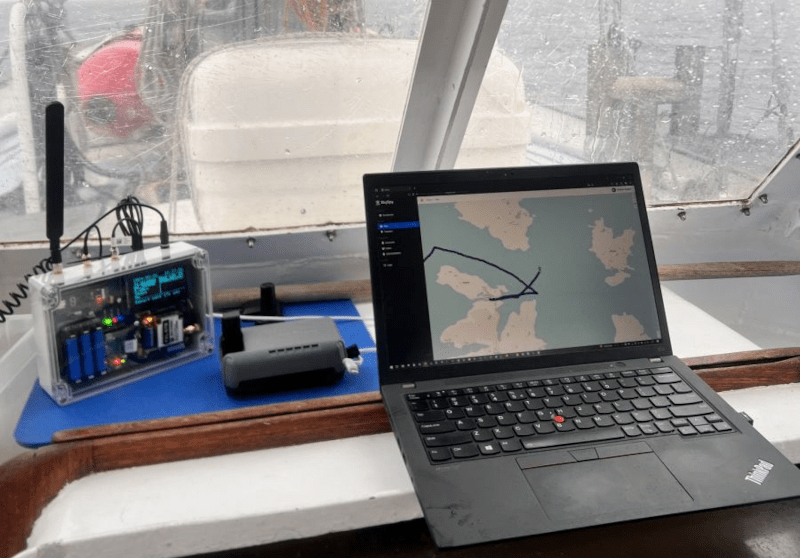Need a weekend project? [Cepa] wanted a GPS tracker that would send data out via LTE or the Iridium network. Ok, maybe that’s one for a very long weekend. However, the project was a success and saw service crossing the Barents Sea in the Arctic. Not bad.
Apparently, [Cepa] is very involved in sharing tracks to odd and remote places. While you may not have cell service in the middle of the Barents Sea, you can always see Iridium. The device does make some sacrifices to the expense of satellite communications. On LTE, the system pings your location every ten seconds. Without it, it dials up the sat connection once an hour. However, it does store data on a SD card, so — presumably — you get caught up when you have a connection.
Hardware-wise, the setup uses an STM32 BlackPill, an OLED, and some off-the-shelf GPS, LTE, and Iridium modules. The system uses an RTOS, which might be overkill, but it makes it easy to program complex behaviors.
In practice, the tracker lost LTE about 20 nautical miles from the Norwegian coast and used the satellite until it was closer to the coast of Svalbard. The problem is that satellite communications come at a high cost. According to the post, the monthly fee was £13, with another £14 for 100 credits, which translates to about 5kB of data. That adds up quickly.
Iridium, however, is sometimes the only choice if you are in the middle of the ocean or an otherwise inaccessible part of the world.
















I think there’s quite a few alternatives to Iridium nowadays, Sateliot have just launched (using NB-IOT) and Astrocast have been around for some years now.
From what I remember Astrocast has a flat monthly rate. And the modules are 77£ on Mouser!
NB-IOT is for stationary units.
Starlink would be better and cheaper and give you waaay more bandwidth which makes Iridium only valuable for backpackers, as long as Elon doesn’t make the groundstations more compact.
For a slow moving ship, Starlink works very well and for about € 50 a month.
The experiment is fun though.
Starlink has vastly more expensive rates for use on the open sea. So no, not about €50 a month.
Power Consumption Average:
Starlink: 75 – 100 W
Iridium Module: 2 W
No more words needed.
Power is not a problem on a sailing boat.. e.g. it has space heaters.
I mean *not sailing boat.
What about SMS to Space promise with unmodified phones?
Tmobile is supposedly in beta with certain Android customers starting back in May/June 2024.
Apple is taking a different path with their own separate satellite service. All iPhone 14 and newer have “Emergency SOS” which makes use of satellite messaging. Supposedly starting with iOS 18 on the same devices, general “Messaging via satellite” becomes available, and is supposedly free for the first 2 years after purchasing a device.
Or so I’ve read. I have a Pixel 7a on Tmobile. The “Satellite message” option shows up if I search settings, but if I tap on it I just end up on the Tmobile connection settings screen with no satellite options. I guess I’m not special enough yet.
Interestingly with the launch of the SARA S520 – see https://www.u-blox.com/en/product/sara-s520bm10-module, you can do all this with much less than 1W power consumption. It will handle both the LTE side and satellite uplink of positioning data. [Obligatory hackaday] You may still need to program a small microcontroller to run it.
At $100+ for the bare module, and a “contact us for a quote” service charge, it doesn’t sound very promising.
And if you want a massive antenna, 300 bps and “sometimes on” connectivity, there’s always HF radio.
You can get rid of the massive antenna: use a small magloop and JS8Call over HF. Position reporting to APRS is included in the protocol.
aroused in HAM
Too bad the Swarm network is sunsetting. This is the sort of thing we designed it for. Intermittent low bandwidth satellite communications that was seriously cheap. $5/mo for 600 messages a month, up to 220 bytes per message. You could also do two-way messaging, but we seriously discouraged that due to bandwidth issues. As far f this morning there’s only 8 days still functioning, and they probably be offline by February.
So badly need to be able to edit comments. As of this morning there are only 8 days still functioning.
8 satellites…